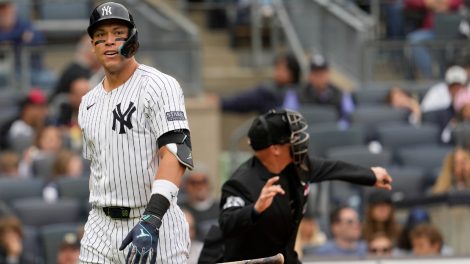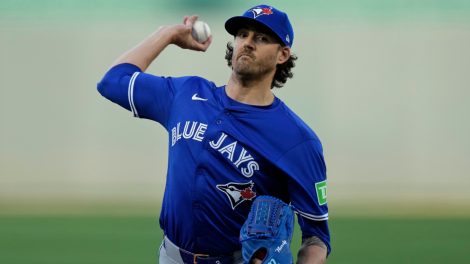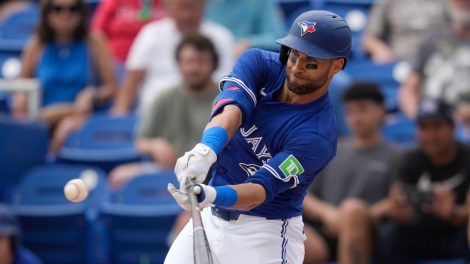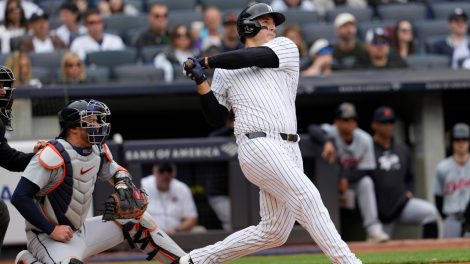ANAHEIM, Calif. – The details of Vladimir Guerrero Jr.’s origin story with the Toronto Blue Jays are well known by now, from clandestine visits to the Dominican Republic by former GM Alex Anthopoulos to the lunch when the slugger’s mother pulled out his Canadian birth certificate.
An oft forgotten addendum to the tale is the July 2 trade of prospects Chase De Jong and Tim Locastro to the Los Angeles Dodgers for international bonus pool slots totalling $1,071,300, a swap completed nearly simultaneously with Guerrero’s $3.9 million agreement.
While landing Guerrero wasn’t dependent on that deal, acquiring the extra spending slots under the old system reduced the penalty levied against the Blue Jays for blowing past their 2015 bonus pool allotment of $2,324,100.
As a result, the Blue Jays were able to sign right-hander Eric Pardinho, ranked as the club’s No. 4 prospect by Baseball America, plus shortstops Miguel Hiraldo (No. 10) and Leonardo Jimenez (No. 21), among others, during the 2017 signing period, one that they would have had to otherwise sit out.
Here’s how it went down.
As the Blue Jays set their sights on Guerrero ahead of the 2015 international signing period, they faced a dilemma. The young slugger had set a very high asking price and Wilton Guerrero, his uncle who had trained him as a youngster and was representing him, wasn’t budging.
Anthopoulos kept pressing Ismael Cruz, the Blue Jays’ director of international scouting at the time, to get the price down, to no avail. And as July 2 approached, they worried that the Kansas City Royals might start making some headway, and there was chatter that the San Diego Padres had started sniffing around. As a result, internal discussions started on whether the massive investment, one that would come with stiff penalties, was worth it.
Under the previous signing bonus pool system, teams didn’t have a hard cap on spending like they do now, but rather a soft one that allowed clubs to exceed their allotment with an increasingly punitive set of consequences.
For overages of greater than 15 per cent – the range the Blue Jays faced – there was a dollar-for-dollar tax as well as an inability to sign players for more than $300,000 in the next two international signing periods. Some teams had taken the approach of going all out in one bonus period, getting as many of the best prospects as possible, and then accepting the punishment.
The Blue Jays didn’t have the money to go that route, but they were determined to land Guerrero and decided that if they had to pay roughly $1.6 million in tax and sit out two signing periods, they would. That’s how much they believed in the player.
“What we liked about the international market the way it was set up was that you had the opportunity in any given year to get the best player on the market,” explains Anthopoulos. “Granted there’s more risk and they’re further away, but we were prepared to sit out two periods (for Guerrero). We didn’t know that we could work out a deal (for more bonus pool slots), and we didn’t know what the ask was going to be. But we were going to try to get more bonus pool money to alleviate the penalty down to one, but we were prepared to be out two.”
Every year, there are teams that don’t use their full allotment in the international market, and unlike most draft picks, those slots can be traded. That summer, the Dodgers were one of those teams and Anthopoulos sought them out.
Initially, the Dodgers asked for Danny Jansen, who was recovering from a broken left hand in 2015 after missing time in 2014 with a knee injury. That would have made it easy to flip him, a 16th-round draft pick with little minor-league track record, but he was a non-starter.
“We thought he had pretty big upside, so we were prepared to sit out the second year rather than give up Danny Jansen,” says Anthopoulos. “Great job by L.A. for identifying Jansen in 2015. Ultimately, we said what if we give you two instead of one, and then we worked on the two.”
Enter De Jong, a second-round pick in 2012 pitching well at low-A Lansing at the time, and Locastro, a 13th-round pick in 2013 with lots of speed and the ability to play around the diamond who was also at Lansing. The pair would get the deal done for the bonus slots but internal debate on whether to use minor-league assets to ease a penalty continued.
“Basically we were trying to decide, OK, we can sit out both signing periods and keep these kids, or we can be down to one period and have to spend money,” explains Anthopoulos. “We viewed it as an upside ceiling play. We wanted the chance that we could do better than Locastro and De Jong (in the second signing period), knowing that they’re years away, they’re going to be 15-16 when we sign them, you have to spend money on the bonus on top of it.
“The view was, both guys have a chance to be big-league guys but we didn’t view their ceilings as potential franchise players, so let’s give ourselves a chance (to get one). If we’re out of the market, we have zero chance to get the best player in the class. If it means giving up those guys, so be it.”
Locastro has appeared in 30 big-league games so far, nine of them with Arizona this season, while De Jong has pitched in 12, one in 2019 with Minnesota.
Pardinho, 18, dominated at rookie-ball Bluefield last season but has missed the start of this year with elbow soreness. Hiraldo, 18, and Jimenez, 17, both played in the rookie-level GCL last year.
The $1,071,300 in slots acquired from the Dodgers reduced the penalty the Blue Jays had to pay on Guerrero by the same amount (that money was later used in the summer’s trade deadline build up). The savings also reduced the overage total on Guerrero to just under 15 per cent (14.86), meaning the secondary penalty went down to being unable to sign players for more than $300,000 in the 2016 international signing period only.
If Pardinho, Hiraldo or Jimenez ever end up playing alongside Guerrero down the road, that clever little side deal will be the reason why.
[relatedlinks]
—
REVAMPED HALL NOW OPEN: The Canadian Baseball Hall of Fame in St. Marys, Ont., celebrated the completion of its renovation and 2,500-square-foot expansion last week ahead of its reopening over the weekend.
The project includes redesigned displays for various artifacts, new interactive exhibits, an archive and library housing the Hall’s historic documents, and an artwork-laden visitors lounge for groups and social events.
This summer’s induction festivities run June 13-15 with Jason Bay, Ryan Dempster, Rob Thomson and Gord Ash set to be honoured.
The Hall is open to visitors 10 a.m. to 5 p.m. Tuesday through Sunday.
—
PATH TO TOKYO 2020: Canada’s first chance to qualify for the 2020 Tokyo Olympics begins play at the 2019 WBSC Premier12 tournament Nov. 6 against Cuba.
The Canadians will play out of Group C in Seoul along with South Korea and Australia, with the top two clubs in each pool advancing to the Nov. 11-16 Super Round in Japan.
The United States, Mexico, Dominican Republic and Netherlands will play out of Group A in Guadalajara, Mexico, while Japan, Chinese Taipei, Venezuela and Puerto Rico will play out of Group B in Taiwan.
The top finishing country from the Americas will earn an Olympic berth, as will the top finisher among Australia, Chinese Taipei and South Korea.
Canada will also be playing in the 2019 Pan Am Games in Lima, Peru this summer.









